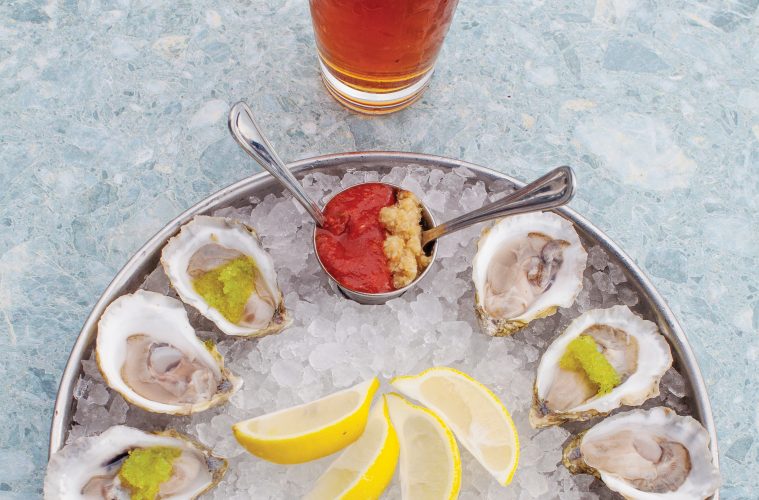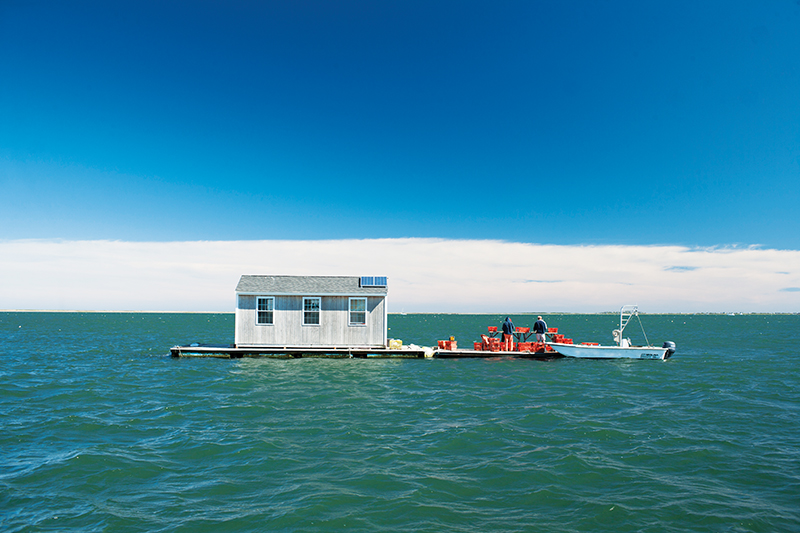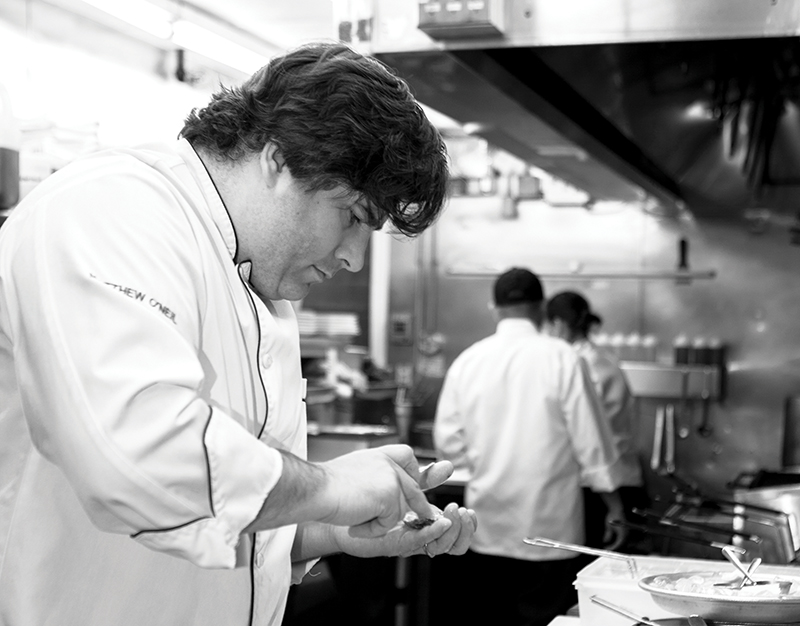Ready a shucking knife and that tiny, seldom- used seafood fork: It’s oyster season! From September through December, the harvest of farm-raised oysters throughout New England and down into Long Island Sound results in a tremendous supply of fresh contenders ready to duke it out in a variety of restaurant raw bar and holiday platter taste tests. The winner is always the sampler (don’t tell the oysters; they try so hard).
Brassy, yeasty, briny, fruity, buttery, and earthy are just some of the adjectives used to describe an oyster’s taste from start to finish. And while oysters hailing from Prince Edward Island, Maine, Massachusetts, Rhode Island, and farther down the coast all exhibit different flavor profiles, it’s interesting to note that they are all the same type. Out of the five oyster species cultivated commercially in North America, the Eastern oyster, Crassostrea virginica, grows along the East Coast from New England to Florida and is noted for being large, firm, and briny.
Writes Rowan Jacobsen in his oyster guidebook, A Geography of Oysters, “The Eastern is the Riesling of oysters. From the wrong place, it can be simple, one-dimensional, almost flavorless, but when grown in great waters, it can achieve a brilliant subtlety and refinement, a transparency of sea and minerals that some consider unsurpassed.”
How can one species propagate so many different experiences on the palate? One could ask the same question about wine, and yet no one assumes one Sauvignon Blanc will taste like another. The reason is that location and growing conditions influence the end product. In an oyster’s case, shell shape, cup depth, and meat quality are impacted by environmental factors like water tempera- ture, salinity, algae levels, mineral presence, mud proximity, and more.
Popularity Contest
When European explorers landed in the New World, they encountered many un- knowns, including the Eastern oyster. Unlike the European Flat variety from back home, this American novelty impressed with its ample meat and clean taste. As Jacobsen writes in his oyster geography, “The Eastern oysters made the European Flats look like wimps. They grew in massive reefs, stretching for miles and rising twenty feet high….They fed prodigiously, grew immensely fat….They were, in short, American.”
But 20-foot-high oyster reefs did not last. “A century ago, people ate a lot of oysters,” relates Chris Sherman, president of Island Creek Oysters, a Duxbury-based shellfish farm and wholesaler. “There was an oyster bar on every street corner in New York City, and they were sold in taverns throughout Boston,” he continues. “But a combination of overfishing, pollution, and diseases affected the East Coast’s two main producing regions, the Chesapeake and Long Island Sound, and much of the wild population died. Once the supply went away, oysters fell out of our gastronomic culture.”
During the past decade or so, supply and demand have increased once again thanks to the rise of aquaculture. While wild oysters are still harvested via residential shellfish permits, wild populations are not strong enough to support the sizable commercial activity in Massachusetts. Instead, most oysters available in seafood markets and on restaurant menus today are farmed by growers who lease space in “designated shellfish growing areas” managed by individual towns in collaboration with the Massachusetts Division of Marine Fisheries.
Farm Fresh
|
Island Creek has made a name for itself in the oyster world since its humble beginnings as a clam provider. In the early 1990s, founder Skip Bennett was growing quahogs in Duxbury Bay when he decided to give oysters a try. At first, observers thought he was crazy—but not anymore.
Today, the “Island Creek Oyster” is highly sought-after throughout New England and beyond as an upper-class varietal right up there with Wellfleets, Bluepoints, and Moonstones. “We’re fortunate because southern Massachusetts is considered the Napa Valley of oysters,” says Sherman. “Island Creek Oysters have a really strong salt content up front, a buttery middle section with mossy, grassy notes, and a nice sweet finish.
“Duxbury Bay is the main driver of flavor,” he continues. “It’s a protected barrier beach ecosystem with very little fresh-water influence. The water is not brackish, there is an 11-to 12-foot tidal swing, and southwest winds regularly clear warm surface water out to sea. All of this creates very cold, very salty water,” he notes.
Every spring, Island Creek grows oyster seeds in its own hatchery, and these baby oysters, measuring only 2 millimeters first, are nurtured in “upwellers” (a contraption of the company’s own design) before graduating to the “nursery,” a series of cages and mesh bags that sit on the bay’s bottom. Once the oysters are about 2 inches in length, they are planted directly on the sea floor. Usually, by August, 18 months after the seedlings first arrived, the crop is ready and the harvest begins.
In comparison, owner Mark Begley’s Beach Point Oysters mature off the ground in large hanging baskets. Their nursery is Barnstable Harbor, which is protected by the Cape’s famous barrier beach, Sandy Neck. “Every growing area is unique, and every grower tends to do things a little bit differently,” says Begley, who operates his farm part-time on weekends. When stock runs out sometime after the new year starts, he doesn’t mind: “Barnstable Harbor is not that much fun in February,” he laughs.
Growers like Island Creek and Beach Point are quick to point out that unlike other types of farming, shellfish aquaculture actually improves water quality. Shellfish remove harmful nitrogen from seawater by ingesting it into their tissues and shells. More importantly, they feed on the phytoplankton that consumes nitrogen (more nitrogen equals more phytoplankton, which is a problem, since phytoplankton creates harmful algae blooms).
“Shellfish aquaculture represents the only widely cultivated form of protein that is a net benefit to the environment where it’s grown,” asserts Sherman.
Eating Out
|
“We’ve had a raw bar on the bar since day one,” says George Carey, founder of Finz Seafood & Grill in Salem. “We’ve been serving oysters since before they were in vogue and we’ll still be serving them after. Oysters are a big part of who we are,” he continues. “We deal in high volume, we buy every day, and we attempt to run out at the end of each night.”
Seafood is taken seriously at the Pickering Wharf restaurant, now in its 14th year, and it’s no surprise that the oyster selection is carefully culled. Carey sources his oysters from a Boston-based broker, who in turn buys direct from up to 40 different growers—he opts for wet-stored oysters, which are housed in saltwater tanks post-harvest just like lobsters. “We pay more but feel it’s a superior product,” he explains.
On any given day, Finz’s raw bar includes four different oysters, typically hailing from New England but sometimes farther afield. This fall, the restaurant launched a one-dollar oyster “happy hour” from 4:00 to 6:00 p.m. and again from 10:00 to 11:00 p.m. “They are pure protein and the perfect late-night snack,” boasts Carey.
Serie Keezer, Finz’s executive chef, appreciates the oyster’s full potential, and his specialty is a doozy: The aptly named “Finz Oyster” is shucked and topped with wasabi caviar (a mix of whitefish roe and wasabi powder) and a splash of Stoli “Razberi” vodka. “It has a citrus taste,” says the chef, “and it’s a nice change from the savoriness of cocktail sauce.”
Matt O’Neil, executive chef and owner of The Blue Ox in Lynn, boosts the deliciousness of his cocktail sauce with locally grown horseradish and also prepares a Champagne mignonette sauce daily. Oysters weren’t even on O’Neil’s menu until he convinced Island Creek to deliver, but now they are available in the dining room by the half dozen and are sold in the bar for a dollar apiece from 4:00 to 6:00 p.m. on Tuesdays through Thursdays.
Why Cocktail Sauce?
Historically, oysters were a valued meat source and their post-harvest shelf life was sometimes stretched. Lengthy storage coupled with a lack of adequate refrigeration led to the prevalent garnishes of horseradish and vinegar, which helped mask time-induced musk. However, a self-declared ostreaphile typically indulges without accompaniment in order to distinguish subtleties in the meat and liquor.
No matter the noshing style, one thing is certain: Understanding oysters’ geo- graphic pedigree, discerning their flavor characteristics, and even creating complementary beer and wine pairings are all part of the sampling fun.
RECIPE
????????????GRILLED OYSTERS TOPPED WITH BARBEQUE SAUCE AND MANGO SALSA
Courtesy of Finz
Mango salsa:
2 ripe mangos, small dice
1 red bell pepper, small dice
2 tbs. red onion, diced
1 tsp. jalapeno, finely chopped
2 tbs. cilantro, chopped
1 tsp. honey
1 tbs. rice wine vinegar
Splash of lime juice
Pinch of salt and pepper
Barbeque sauce of choice
Toss salsa ingredients together. Grill the oysters until they open and put a little barbeque sauce on each one. Keep on the grill for about a minute. Remove and garnish with salsa and cilantro sprigs. Pair with a sipping tequila.
STUFFED OYSTERS WITH CRAB
Courtesy of Finz
1/4 c. red bell pepper, diced
2 scallion stalks, diced 2 tsp. Dijon mustard
1 tsp. Tabasco
1 tsp. Worcestershire sauce
Pinch of salt and pepper
1 large egg
1 tbs. chives, chopped
1/2 c. mayonnaise
1 1/4 c. panko breadcrumbs (our preference) or Ritz crackers
1 lb. lump crabmeat
Mix all ingredients except crabmeat and allow to sit for 10 minutes; then add the crab. Shuck the oysters, top with crab mixture and a little butter, and bake in the oven at 375oF until brown. For heightened crispiness, top the butter with extra panko and bake.
CHAMPAGNE MIGNONETTE
Courtesy of The Blue Ox
2 shallots, finely diced
2 tbs. flat-leaf Italian parsley, chopped
8 black peppercorns, coarsely ground with back of a pan
1/2 c. Champagne (most dry sparkling wines using the Champagne method will suffice)
1/2 c. Champagne vinegar
1/4 c. white sugar
In a bowl, mix well with a whisk and chill before using. Use the same day. Makes about 1 1/2 cups.


 Island Creek harvests oysters in Duxbury Bay / Photo by Michael Turek
Island Creek harvests oysters in Duxbury Bay / Photo by Michael Turek The Blue Ox’s Chef Matt O’Neil prepares a plate / Photo by Elise Donoghue
The Blue Ox’s Chef Matt O’Neil prepares a plate / Photo by Elise Donoghue